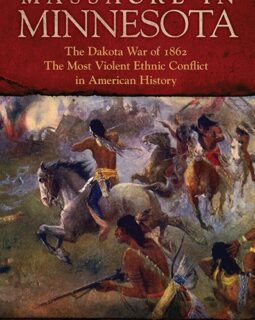Massacre in Minnesota: The Dakota War of 1862, the Most Violent Ethnic Conflict in American History

- Year
- 2019
- Creators
- Reviewer: Mary Lethert Wingerd
- Topics
Massacre in Minnesota: The Dakota War of 1862, the Most Violent Ethnic Conflict in American History
Gary Clayton Anderson
Norman, OK: University of Oklahoma Press, 2019
384 pages; hardcover, 42 b&w illustrations, 2 maps, $32.95
Did we really need another book about the Dakota War? My response is a resounding affirmative when the historian is as accomplished, thorough, and knowledgeable as Gary Clayton Anderson. From the outset, Anderson makes clear that he intends to pull no punches. His intention is writ large in the title itself: “Massacre in Minnesota.” This term has not been acceptable in describing the Dakota War for at least twenty years, recalling sensational, anti-Indian accounts that held sway for more than a century following the events.
Yet Anderson is no reactionary revisionist. Two previous, related books—Kinsmen of Another Kind: Dakota-White Relations in the Upper Mississippi Valley, 1650-1862 and Little Crow: Spokesman for the Sioux—demonstrate a textured understanding of the Dakota people and their culture. In fact, more than any other working historian, he has the bona fides to establish a balance between narratives that described Dakota warriors as bloodthirsty savages and those that characterized them as epic figures fighting a last battle to save their homeland. In Anderson’s telling, there are few heroes or villains in this calamitous ethnic conflict, a tragedy that wreaked almost unimaginable wreckage on everyone it touched.
As the title notes, the Dakota War was indeed the most violent ethnic conflict in American history and, as in all wars, atrocities occurred and innocent people died, sometimes in horrific ways. By refusing to elide these realities, Anderson treats the Dakota, as well as the whites, as fully articulated humans, capable of both good and evil. In the chapters leading up to the war itself, he delineates the blunders, corruption, and rampant thievery of Minnesota’s leading men that finally provoked some Dakota warriors to a violent response. But he also argues that, by definition, the attacks on unarmed, unsuspecting settlers—more than 600 people died—certainly constituted a massacre. Nonetheless, this was not a war made by the “Dakota Nation,” which simply did not exist in the unitary form understood by Euro-Americans. Rather it was a strike by primarily young Mdewakanton warriors that swept other, often unwilling, Dakotas into its vortex. And all the Dakota people were punished in the aftermath and exiled from their homeland, a profound and tragic injustice.
Anderson notes in the preface that, for many years, he has been pondering how this dreadful event had come to happen. It was so out of character for the Dakota people who had never been aggressive toward white interlopers, despite innumerable offenses against them. Who bore responsibility for this eruption of violence? In search of answers, he engaged in a massive, yearslong research project, mining archives throughout the country for official documents and unearthing hundreds of first-person testimonies and accounts, dozens from Dakota individuals as well as from whites. The result is an evidence-driven narrative that sheds new light on important aspects of the conflict.
One chapter of particular note examines the treatment of the many white women who were taken captive during the hostilities. The common wisdom has been that very few captives had been victims of sexual assault because almost none testified to their violation. Anderson makes a compelling case that rape was a much more common experience than was officially reported, but he also notes that many of the captors saw it quite differently. Most of the warriors who took women captives intended to have them as wives, not simply as spoils of conquest. In fact, there was a serious shortage of marriageable-age girls among the Dakota. Severe hardships on the reservation had driven many young women to trade on their sexuality, living with traders, soldiers, or other white men in return for food and relative safety for themselves and their families. Yet another grievance to stoke Dakota fires of resentment, as well as motivation to capture white women to take their place. When viewed within this larger context, captivity narratives take on added complexity, a richness of description that enhances the volume as a whole.
The author’s style is one of dispassionate reportage with very little overt analysis. Though his perspective certainly shapes the narrative, in large part, he lets the evidence speak for itself. And speak it does, loudly and dramatically, without undue favor to either side. Though I may not entirely agree with all Anderson’s conclusions, I greatly appreciate this important contribution to Minnesota history. This is the most balanced, thorough, and scholarly sound account of the Dakota War to be published. And it is eminently readable as well. For anyone with an interest in Minnesota history, Massacre in Minnesota is highly recommended.
Mary Lethert Wingerd is an emerita professor of history at St. Cloud State University in St. Cloud, Minnesota. She is the author of North Country: The Making of Minnesota and Claiming the City: Politics, Faith, and the Power of Place in St. Paul. She also is a member of the Ramsey County Historical Society editorial board and a contributing writer to Ramsey County History.
- Year
- 2019
- Creators
- Reviewer: Mary Lethert Wingerd
- Topics